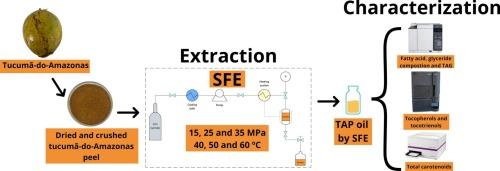超临界流体萃取亚马孙树(Astrocaryum acleatum)果皮废油
IF 8
1区 农林科学
Q1 FOOD SCIENCE & TECHNOLOGY
引用次数: 0
摘要
采用超临界流体萃取法(SFE)从仙人掌本文章由计算机程序翻译,如有差异,请以英文原文为准。

Supercritical fluid extraction of oil from spent Tucumã-do-Amazonas (Astrocaryum aculeatum) peel
Supercritical fluid extraction (SFE) was applied to obtain oil from the tucumã-do-Amazonas (Astrocaryum aculeatum) peel (TAP). SFE was performed using CO2 as solvent at different pressures and temperatures. The extracts were characterized for their global yield, lipid content, fatty acid and triacylglycerol profiles, carotenoid and tocopherol content and infrared spectra by FTIR. Mathematical modeling of the SFE curves was also performed using the three-line Spline model. The global yield was approximately 17 g/100 g TAP, with the oil consisting mainly of triacylglycerols of oleic, linoleic, palmitic, and stearic acids, and carotenoid content of 80.62 mg β-carotene/100 g extract and 13.49 mg β-carotene/100 g TAP obtained at 35 MPa and 40 °C. The observed FTIR spectra are similar to those reported in the literature for other vegetable oils, exhibiting minor differences in band frequency and transmittance intensity. The three-line Spline model successfully described the kinetic behavior of SFE for TAP, indicating that SFE at 35 MPa and 40 °C is an efficient method for obtaining oil from TAP with an extraction time of 40 min. Therefore, TAP can be considered a potential source of bioactive compounds that can be recovered using SFE, an environmentally sustainable extraction method, allowing this residue to be repurposed into a potential oil suitable for food, health, and cosmetic applications.
求助全文
通过发布文献求助,成功后即可免费获取论文全文。
去求助
来源期刊

Food Research International
工程技术-食品科技
CiteScore
12.50
自引率
7.40%
发文量
1183
审稿时长
79 days
期刊介绍:
Food Research International serves as a rapid dissemination platform for significant and impactful research in food science, technology, engineering, and nutrition. The journal focuses on publishing novel, high-quality, and high-impact review papers, original research papers, and letters to the editors across various disciplines in the science and technology of food. Additionally, it follows a policy of publishing special issues on topical and emergent subjects in food research or related areas. Selected, peer-reviewed papers from scientific meetings, workshops, and conferences on the science, technology, and engineering of foods are also featured in special issues.
 求助内容:
求助内容: 应助结果提醒方式:
应助结果提醒方式:


